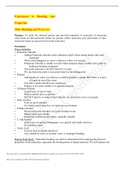Exam (elaborations)
CHEM 103 experiment 6 : Bonding and properties (Portage learning)
- Course
- Institution
CHEM 103 experiment 6 : Bonding and properties (Portage learning)/CHEM 103 experiment 6 : Bonding and properties (Portage learning)/CHEM 103 experiment 6 : Bonding and properties (Portage learning)/CHEM 103 experiment 6 : Bonding and properties (Portage learning)/CHEM 103 experiment 6 : Bonding and...
[Show more]



